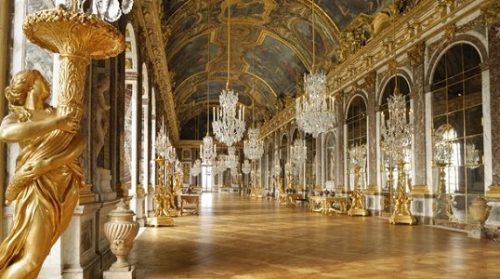The Versailles’Palace is one of the UNESCO’s World Heritage List. It is very famous, not only for its beauty but also as a symbol of absolute monarchy of the Ancient Regime.
In Domain of Versailles, you can visit these main sights :
- Palace of Versailles (Château de Versailles)
- Gardens and Park
- Trianon Palace
- Marie-Antoinette’s Estate
See my prefers sights indicated by *
1. Palace of Versailles
In the 1660s, the young king Louis XIV began to transform the hunting castle of Louis XIII. The architect was Louis Le Vau. André Le Nôtre begans to create « French-style » Gardens of Versailles.
In 1678, Louis XIV, named « Sun King », decided to expand the castle into a Palace. The architect Jules Hardouin-Mansart created the Hall of Mirrors, decoreated by the painter Charles Le Brun. The famous Hall of Mirrors was a waiting and meeting place where the King showed his royal power to impress visitors.
In 1682, the King moved the court and the government of France from Paris to Versailles.
In 1837, Louis-Philippe converted it into a museum of French History.
In 1919, World War I ended in Hall of Mirrors with signing the Treaty of Versailles with Clémenceau (France), Wilson (Uned States), Lloyd George (United Kingdom), Orlando (Italy), Müller and Bell (Germany).
In Versailles’ Palace , you can see first :
- Hall of Mirrors*
- King ‘s Grand Apartment
- King’s Chamber*
- Queens’ Grand Apartment
- King’s interior apartments
- Royal Chapel*
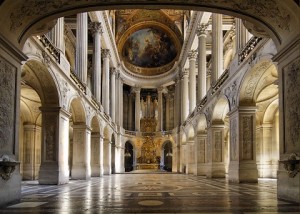
You can also see :
- Crown Prince’s Apartment (Appartement du Dauphin et de la Dauphine) [currently close]
- Louis XV’s daughters apartments [can be visit only during the week-end]
- Marie-Antoinette’s Apartments
- Marquise de Pompadour’s Apartment
- Museum of French History : paintings and sculptures which show the great national history of France since the Middle Ages.
- Congress room used in the 19th century
- Gallery of the History of the Palace
- Battles Gallery
- Royal Opera
Back to top of Versailles’s Mains sights
2. Gardens and Park of the Palace
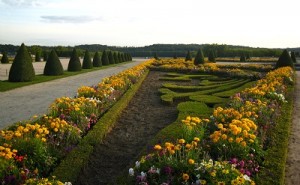
André Le Nôtre created a vast perspective of grasslands and Water Parterre from the front Palace of Versailles.
In these « French-style » Gardens, he put up trees from all the provinces of France, the Canal, fountains and sculptures.
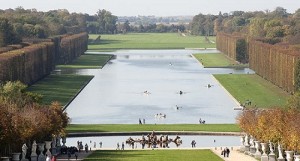
The Grand Canal is the original creation of André Le Nôtre who transformed the east-west perspective into a long expanse of water. It was use to sail and for nautical shows.
The architect Jules Hardouin-Mansart built the Orangerie. Oranges, lemon and pomegranate trees are put indoors during the winter.
In Gardens and Park of Versailles, you can see :
- 11 Fountains, like Latona or Bacchus Fountain*
- Grand Canal*
- Waters Parterres : two large rectangular pools reflect the sunlight and the façade of the Palace
- Walks : The Royal Walk (also called the “Green Carpet” is 335 metres long and 40 metres wide), the Water Walk, Flora and Ceres Walk, Bacchus and Saturn Walk
- Many sculptures*
- 15 Groves (« bosquets ») : little forest often fitted out for a walk or for pleasure.*
Back to top of Versailles’s Mains sights
3. Grand Trianon
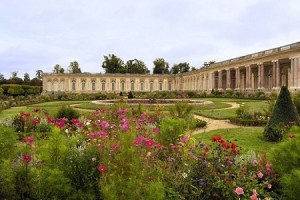
In Grand Trianon, you can see :
- Empress’ Apartment used by Napoleon at the beginning of the 19th century*
- Trianon-sous-Bois : group of apartments for the king’s sister-in-law
- Grand Apartment*
- Emperor’s Small Apartment*
- Trianon’s Gardens
Back to top of Versailles’s Mains sights
4. Marie-Antoinette’s Estate
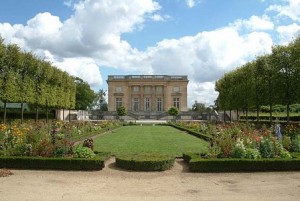
This estate is totally dedicated to the Queen Marie-Antoinette. The Petit Trianon, the Hamlet and the Gardens reveal Marie-Antoinette’s private life. Louis XVI’s wife loved this place where she could be away from the court of Versailles.
In Marie-Antoinette’s Estate, you can see :
- Petit Trianon*
- Queen’s Hamlet where Marie-Antoinette found the charms of country life. There the Queen plays the farmer’s life. It became a real farm, directed by a farmer, whose products foods for the kitchens of the Palace.*
- Queen’s Theatre
- Orangery of Jussieu created by Louis XV to experiment on the acclimatization of exotic or rare plants : geraniums, strawberries, pineapples, coffee, rice, tobacco…
- French Gardens*
- English Gardens*
